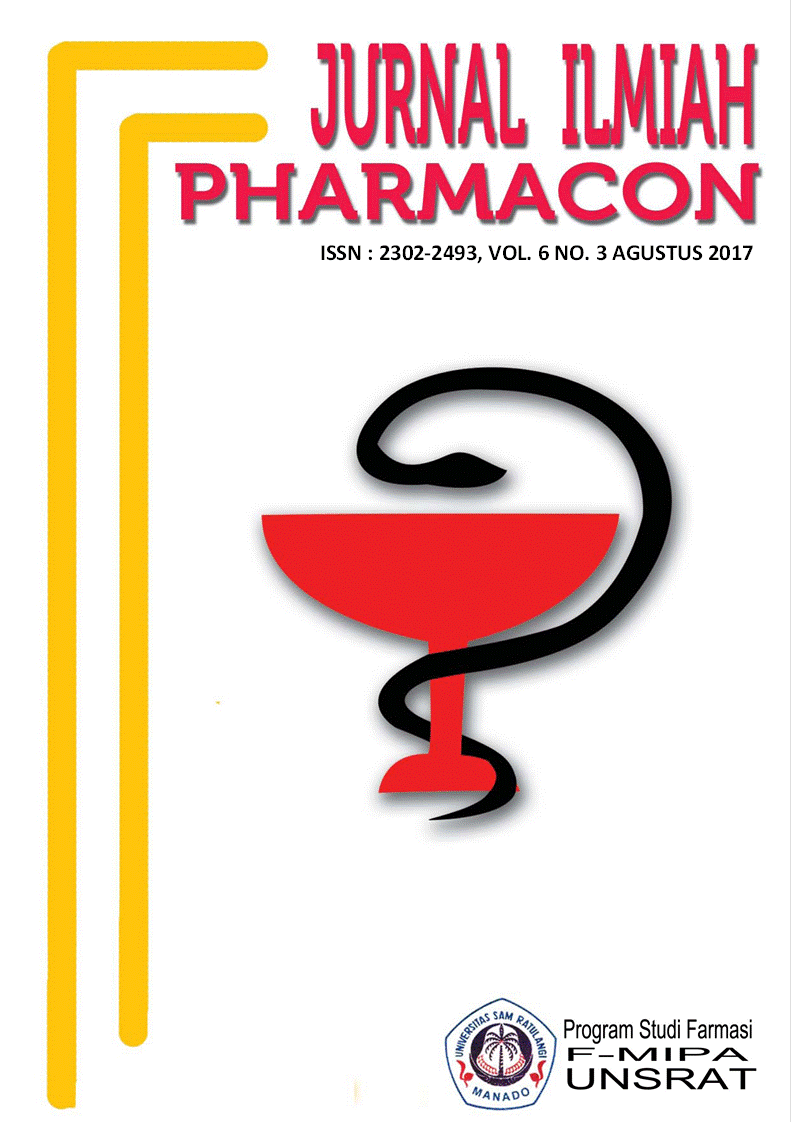PENGARUH EKSTRAK ETANOL BUAH PINANG YAKI (Areca vestiaria) TERHADAP GAMBARAN MAKROSKOPIS ORGAN HATI PADA TIKUS PUTIH JANTAN GALUR WISTAR (Rattus norvegicus)
DOI:
https://doi.org/10.35799/pha.6.2017.16583Abstract
PENGARUH EKSTRAK ETANOL BUAHÂ PINANG YAKI (Areca vestiaria) TERHADAP GAMBARAN MAKROSKOPIS ORGAN Â HATI Â PADA TIKUS PUTIH JANTAN GALUR
WISTAR (Rattus norvegicus)
Â
Jessica Regina Liwandouw1), Herny Simbala1), Widdhi Bodhi1)
 1)Program Studi Farmasi FMIPA UNSRAT Manado, 95115
Â
                                                                 ABSTRACT                                                                Â
Â
The crownshaft plant (Areca vestiaria) is used by the community as a traditional medicine ingredient. Crownshaft palm nuts appears to be a multi-function plant.Where the people of North Sulawesi usually use this plant to cure various diseases such as diabetes and diarrhea, also as a contraceptive, empirically.Clinically the use of traditional medicine is not recognized, if not scientifically proven it’s efficacy and safety.The aim of this research is to know the effect of crownshaft palm nut (Areca vestiaria) extracts against macroscopic description of liver organ in white male wistar rats (Rattus norvegicus).This study was conducted using the animal experiments of twelve male white rats wistar strain.The extraction was done by maceration using 96% of ethanol.Treatment was conducted for 40 days and after that the surgery and macroscopic observation was done.The results showed that the color consistency and the surface of the liver organ in all treatments appeared normal. There is no difference in all treatments of the weight of rat body and the liver organ after using the statistic test of One Way ANOVA. It can be concluded that the crownshaft palm nuts does not affect the liver organ of male rats wistar (Rattus norvegicus).
Â
Keywords: Crownshaft palm (Areca vestiaria), macroscopic liver, white rat (Rattus norvegicus)
Â
ABSTRAK
Â
Tumbuhan pinang yaki (Areca vestiaria) digunakan oleh masyarakat sebagai bahan obat tradisional. Pinang yaki ternyata merupakan tanaman multi fungsi. Dimana masyarakat Sulawesi Utara biasanya menggunakan secara empiris tanaman ini untuk menyembuhkan berbagai macam penyakit seperti diabetes dan diare, juga suatu obat kontrasepsi. Secara klinik penggunaan obat tradisional tidak diakui, bila belum terbukti secara ilmiah khasiat maupun keamanannya. Penelitian ini dilakukan bertujuan untuk mengetahui pengaruh ekstrak etanol buah pinang yaki (Areca vestiria) terhadap gambaran makroskopis organ hati pada tikus putih jantan galur wistar (Rattus norvegicus). Penelitian ini dilakukan menggunakan hewan percobaan tikus putih jantan galur wistar berjumlah 12 ekor. Ekstraksi dilakukan dengan cara maserasi menggunakan etanol 96%.Perlakuan dilakukan selama 40 hari dan setelah itu dilakukan pembedahan dan pengamatan secara makroskopis. Hasil penelitian menujukkan bahwa warna konsistensi dan permukaan organ hati pada semua perlakuan terlihat normal. Pada berat badan tikus serta berat organ hati tikus dengan uji statistika menggunakan metode One Way ANOVA pada semua perlakuan tidak terlihat perbedaan. Dapat disimpulkan bahwa buah pinang yaki tidak memberi pengaruh terhadap organ hati tikus putih jantan galur wisar (Rattus norvegicus).
Â
Kata Kunci : Pinang yaki (Areca vestiaria), makroskopis hati, tikus putih (Rattus norvegicus)
Â
Downloads
Published
How to Cite
Issue
Section
License
Authors who publish with this journal agree to the following terms:
- Authors retain copyright and grant the journal right of first publication with the work simultaneously licensed under a Creative Commons Attribution-NonCommercial 4.0 International License that allows others to share the work with an acknowledgement of the work's authorship and initial publication in this journal.
- Authors are permitted and encouraged to post their work online (e.g., in institutional repositories or on their website) prior to and during the submission process, as it can lead to productive exchanges, as well as earlier and greater citation of published work (See The Effect of Open Access)










